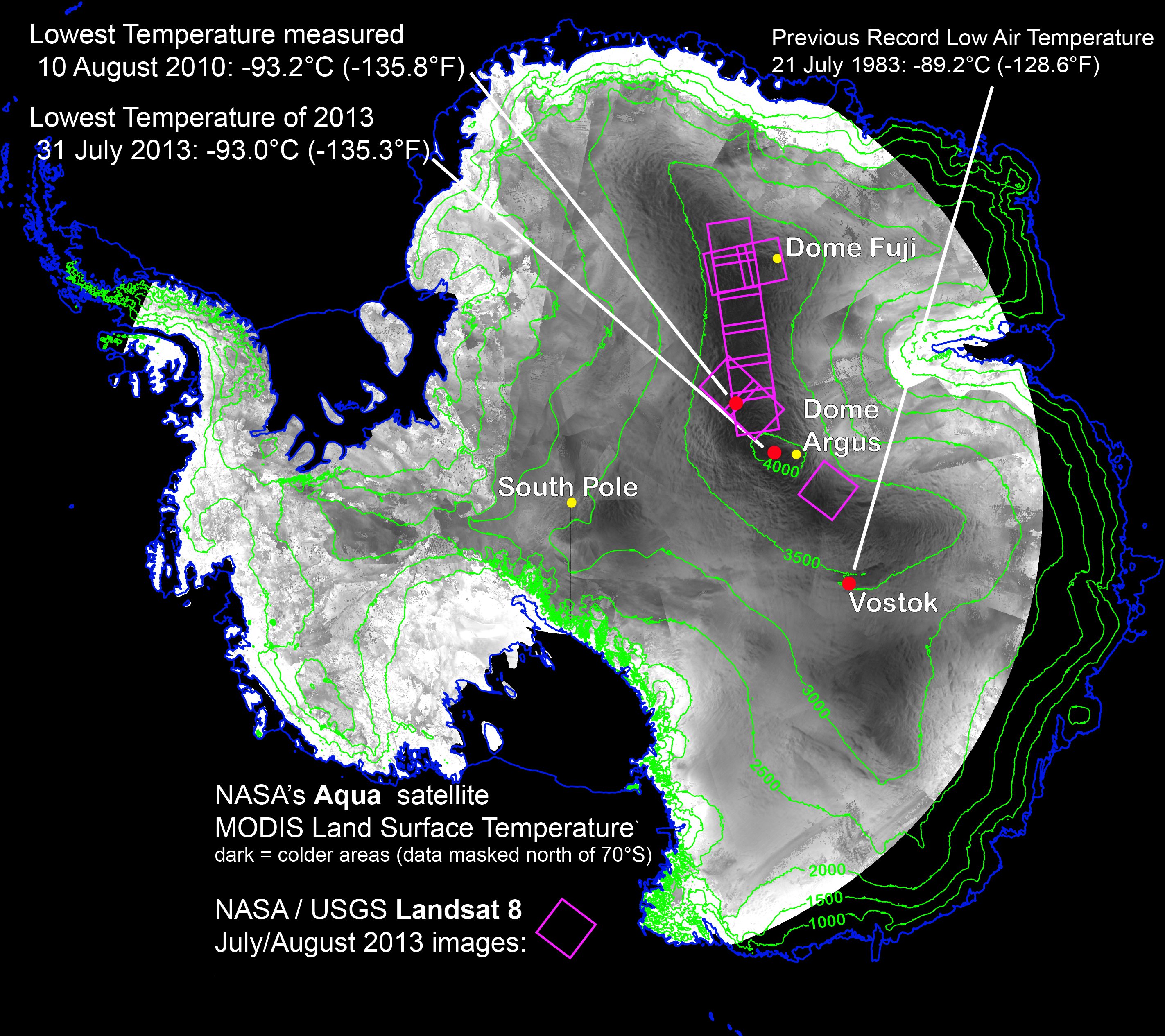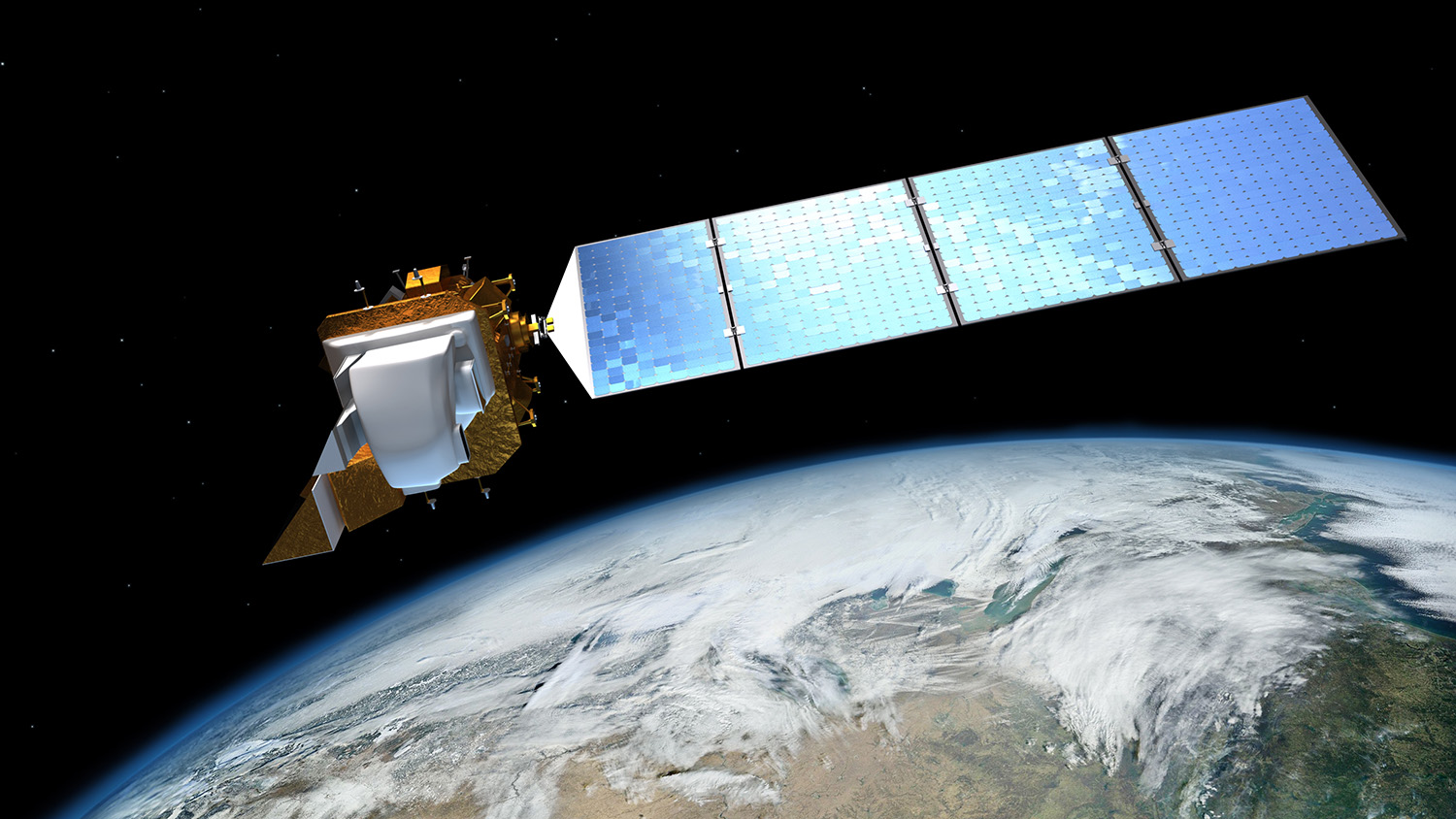Earth
ID: 11432
At 2:30pm (PST) on Monday, Dec. 9, 2013, there was be a press conference as part of the American Geophysical Union Fall Meeting.
What is the coldest place in the world? It is a high ridge in Antarctica on the East Antarctic Plateau where temperatures in several hollows can dip below minus 133.6° Fahrenheit (minus 92° Celsius) on a clear winter night – colder than the previous recorded low temperature.
Scientists at the National Snow and Ice Data Center made the discovery while analyzing the most detailed global surface temperature maps to date, developed with data from remote sensing satellites including the MODIS sensor on NASA's Aqua satellite, and the TIRS sensor on Landsat 8, a joint project of NASA and the U.S. Geological Survey (USGS).
The researchers analyzed 32 years of data from several satellite instruments that have mapped Antarctica's surface temperature. Near a high ridge that runs from Dome Arugs to Dome Fuji, the scientists found clusters of pockets that have plummeted to record low temperatures dozens of times. The lowest temperature the satellites detected – minus 136° F (minus 93.2° C), on Aug. 10, 2010.
The new record is several degrees colder than the previous low of minus 128.6° F (minus 89.2° C), set in 1983 at the Russian Vostok Research Station in East Antarctica. The coldest permanently inhabited place on Earth is northeastern Siberia, where temperatures dropped to a bone-chilling 90 degrees below zero F (minus 67.8° C) in the towns of Verkhoyansk (in 1892) and Oimekon (in 1933).
Related feature story: http://www.nasa.gov/content/goddard/nasa-usgs-landsat-8-satellite-pinpoints-coldest-spots-on-earth
Briefing Speakers
Ted Scambos, National Snow and Ice Data Center (NSIDC), Cooperative Institute for Research in Environmental Sciences (CIRES), University of Colorado Boulder, Boulder, Colorado, USA;
Jim Irons, Landsat 8 Project Scientist, NASA's Goddard Space Flight Center, Greenbelt, Maryland.
Presenter 1: Ted Scambos


Briefing Materials: Taking Landsat to the Extreme
What is the coldest place in the world? It is a high ridge in Antarctica on the East Antarctic Plateau where temperatures in several hollows can dip below minus 133.6° Fahrenheit (minus 92° Celsius) on a clear winter night – colder than the previous recorded low temperature.
Scientists at the National Snow and Ice Data Center made the discovery while analyzing the most detailed global surface temperature maps to date, developed with data from remote sensing satellites including the MODIS sensor on NASA's Aqua satellite, and the TIRS sensor on Landsat 8, a joint project of NASA and the U.S. Geological Survey (USGS).
The researchers analyzed 32 years of data from several satellite instruments that have mapped Antarctica's surface temperature. Near a high ridge that runs from Dome Arugs to Dome Fuji, the scientists found clusters of pockets that have plummeted to record low temperatures dozens of times. The lowest temperature the satellites detected – minus 136° F (minus 93.2° C), on Aug. 10, 2010.
The new record is several degrees colder than the previous low of minus 128.6° F (minus 89.2° C), set in 1983 at the Russian Vostok Research Station in East Antarctica. The coldest permanently inhabited place on Earth is northeastern Siberia, where temperatures dropped to a bone-chilling 90 degrees below zero F (minus 67.8° C) in the towns of Verkhoyansk (in 1892) and Oimekon (in 1933).
Related feature story: http://www.nasa.gov/content/goddard/nasa-usgs-landsat-8-satellite-pinpoints-coldest-spots-on-earth
Briefing Speakers
Ted Scambos, National Snow and Ice Data Center (NSIDC), Cooperative Institute for Research in Environmental Sciences (CIRES), University of Colorado Boulder, Boulder, Colorado, USA;
Jim Irons, Landsat 8 Project Scientist, NASA's Goddard Space Flight Center, Greenbelt, Maryland.
Presenter 1: Ted Scambos


Related
Credits
Lori Perkins (NASA/GSFC): Lead Animator
Matthew R. Radcliff (USRA): Animator
Matthew R. Radcliff (USRA): Video Editor
Matthew R. Radcliff (USRA): Producer
Ted Scambos (NSIDC): Scientist
James R. Irons (NASA/GSFC): Scientist
Matthew R. Radcliff (USRA): Videographer
Kate Ramsayer (Telophase): Writer
Matthew R. Radcliff (USRA): Animator
Matthew R. Radcliff (USRA): Video Editor
Matthew R. Radcliff (USRA): Producer
Ted Scambos (NSIDC): Scientist
James R. Irons (NASA/GSFC): Scientist
Matthew R. Radcliff (USRA): Videographer
Kate Ramsayer (Telophase): Writer
Please give credit for this item to:
NASA's Goddard Space Flight Center except for the items listed under Ted Scambos, which are credited to NASA's Goddard Space Flight Center based on data from the National Snow and Ice Data Center.
NASA's Goddard Space Flight Center except for the items listed under Ted Scambos, which are credited to NASA's Goddard Space Flight Center based on data from the National Snow and Ice Data Center.
Short URL to share this page:
https://svs.gsfc.nasa.gov/11432
Mission:
Landsat
This item is part of this series:
Narrated Movies
Goddard TV Tape:
G2013-096 -- Coldest Place on Earth
Keywords:
SVS >> Antarctic
SVS >> HDTV
SVS >> Landsat
GCMD >> Earth Science >> Spectral/Engineering >> Infrared Wavelengths >> Thermal Infrared
GCMD >> Location >> Antarctica
SVS >> Meteorological Phenomenon
SVS >> MODIS
NASA Science >> Earth
GCMD keywords can be found on the Internet with the following citation: Olsen, L.M., G. Major, K. Shein, J. Scialdone, S. Ritz, T. Stevens, M. Morahan, A. Aleman, R. Vogel, S. Leicester, H. Weir, M. Meaux, S. Grebas, C.Solomon, M. Holland, T. Northcutt, R. A. Restrepo, R. Bilodeau, 2013. NASA/Global Change Master Directory (GCMD) Earth Science Keywords. Version 8.0.0.0.0
https://svs.gsfc.nasa.gov/11432
Mission:
Landsat
This item is part of this series:
Narrated Movies
Goddard TV Tape:
G2013-096 -- Coldest Place on Earth
Keywords:
SVS >> Antarctic
SVS >> HDTV
SVS >> Landsat
GCMD >> Earth Science >> Spectral/Engineering >> Infrared Wavelengths >> Thermal Infrared
GCMD >> Location >> Antarctica
SVS >> Meteorological Phenomenon
SVS >> MODIS
NASA Science >> Earth
GCMD keywords can be found on the Internet with the following citation: Olsen, L.M., G. Major, K. Shein, J. Scialdone, S. Ritz, T. Stevens, M. Morahan, A. Aleman, R. Vogel, S. Leicester, H. Weir, M. Meaux, S. Grebas, C.Solomon, M. Holland, T. Northcutt, R. A. Restrepo, R. Bilodeau, 2013. NASA/Global Change Master Directory (GCMD) Earth Science Keywords. Version 8.0.0.0.0












